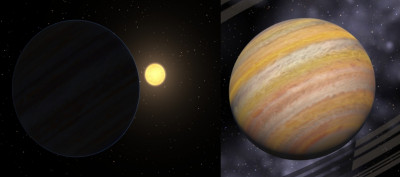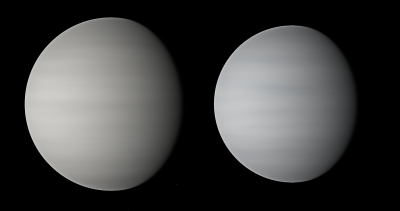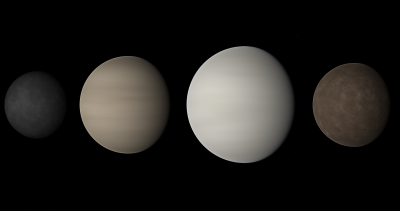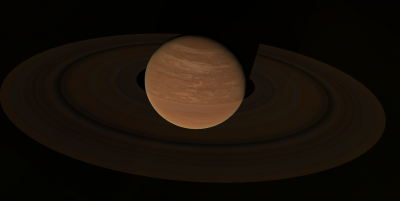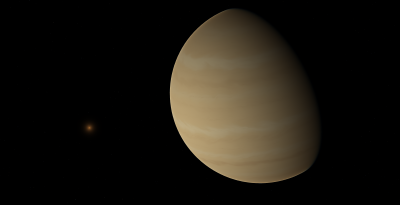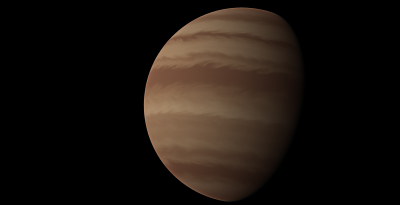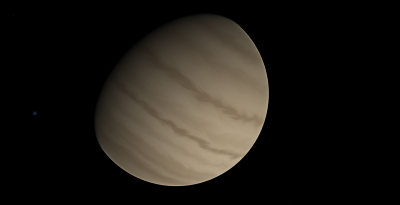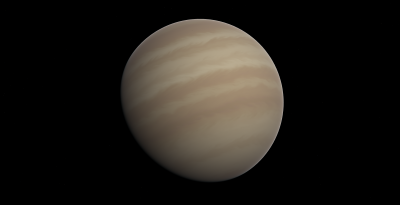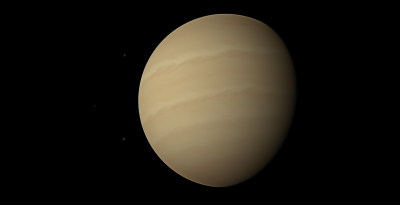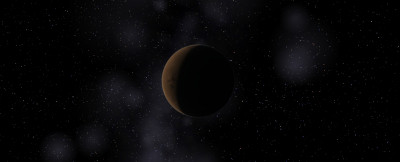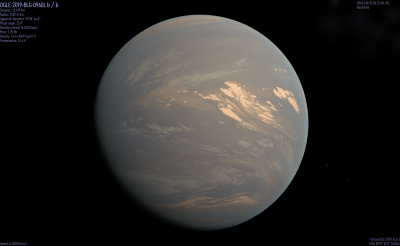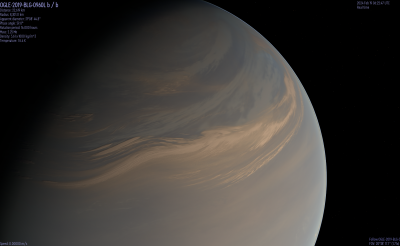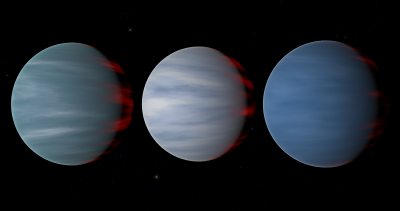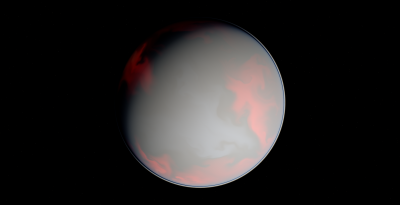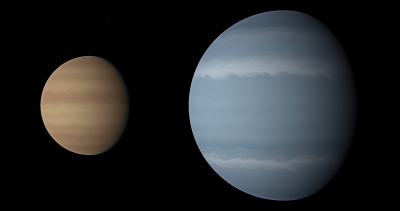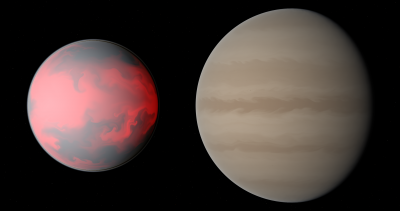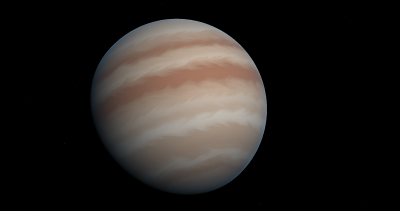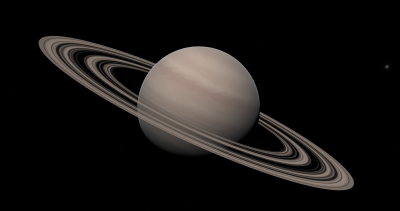Project Sisyphus - Texturing/painting every exoplanet known
- Galaxy-Leaper
- Posts: 17
- Joined: 02.09.2023
- With us: 8 months 7 days
TOI-4600
TOI-4600 is a star slightly smaller than the Sun, approximately 815 light-years away from Earth. This star is also known as TIC232608943 and 2MASSJ17134806+6433581. Two exoplanets, TOI-4600b and TOI-4600c, were discovered around TOI-4600. The inner exoplanet, TOI-4600b, has a mass 6.8 times larger than Jupiter and an orbital period of 83 days. The outer exoplanet TOI-4600c has a mass 9.4 times that of Jupiter and an orbital period of 483 days.
TOI-4600 is a star slightly smaller than the Sun, approximately 815 light-years away from Earth. This star is also known as TIC232608943 and 2MASSJ17134806+6433581. Two exoplanets, TOI-4600b and TOI-4600c, were discovered around TOI-4600. The inner exoplanet, TOI-4600b, has a mass 6.8 times larger than Jupiter and an orbital period of 83 days. The outer exoplanet TOI-4600c has a mass 9.4 times that of Jupiter and an orbital period of 483 days.
- Attachments
-
 TOI-4600.zip
TOI-4600.zip- (33.1 MiB) Downloaded 117 times
TOI-904
a red dwarf with separated twin worlds
Both planets of TOI-904
TOI-904 is a red dwarf located about 150.24 lightyears from the solar system. This star hosts two planets, both mini-Neptunes. the outer one residing in TOI-904's habitable zone.
[Download] (7.96 MB)
a red dwarf with separated twin worlds
Both planets of TOI-904
TOI-904 is a red dwarf located about 150.24 lightyears from the solar system. This star hosts two planets, both mini-Neptunes. the outer one residing in TOI-904's habitable zone.
[Download] (7.96 MB)
- SevenSpheres
- Moderator
- Posts: 820
- Joined: 08.10.2019
- With us: 4 years 7 months
Gurren Lagann @ 2023-11-16 wrote:Tonight on arXiv: 2 new planets around Teegarden's Star using CARMENES GTO and Legacy-Plus
Awaiting for that just because all sub-10 pc planets are done!
Well, it took a few months and there's only one new planet, but here it is! I'm working on updating/re-releasing some addons in the Nearby Exoplanets collection, which... also hasn't been touched for a few months. Hopefully that will include Teegarden's Star.
My Addons: viewtopic.php?f=23&t=19978 • Discord server admin
Celestia versions: 1.5.1, 1.6.1, 1.6.2, 1.7.0, and some unofficial versions like Celestia-ED
Celestia versions: 1.5.1, 1.6.1, 1.6.2, 1.7.0, and some unofficial versions like Celestia-ED
LHS 1903
a multiplanet system with a large rocky planet
all four worlds of LHS 1903
LHS 1903, aka TOI-1730, is a red dwarf located about 116.27 lightyears from the solar system. this star hosts four planets consisting of two super-Earths, an Oceanic planet, and a mini-Neptune. the middle two planets (c, d) likely have a more volatile-rich composition compared to the inner and outermost (b, e) which are rocky-dominated.
[Download] (32.2 MB)
a multiplanet system with a large rocky planet
all four worlds of LHS 1903
LHS 1903, aka TOI-1730, is a red dwarf located about 116.27 lightyears from the solar system. this star hosts four planets consisting of two super-Earths, an Oceanic planet, and a mini-Neptune. the middle two planets (c, d) likely have a more volatile-rich composition compared to the inner and outermost (b, e) which are rocky-dominated.
[Download] (32.2 MB)
- Galaxy-Leaper
- Posts: 17
- Joined: 02.09.2023
- With us: 8 months 7 days
Wolf 327
A new member of the pack of ultra-short-period super-Earths around M dwarfs
Wolf 327 b
A new member of the pack of ultra-short-period super-Earths around M dwarfs
Wolf 327 b
- Attachments
-
 Wolf 327.zip
Wolf 327.zip- (34.83 MiB) Downloaded 41 times
- SevenSpheres
- Moderator
- Posts: 820
- Joined: 08.10.2019
- With us: 4 years 7 months
Teegarden's Star
Two temperate Earths and the nearest cold Earth
It's here! Along with addons for every other confirmed planetary system within 10 parsecs.
Two temperate Earths and the nearest cold Earth
It's here! Along with addons for every other confirmed planetary system within 10 parsecs.
My Addons: viewtopic.php?f=23&t=19978 • Discord server admin
Celestia versions: 1.5.1, 1.6.1, 1.6.2, 1.7.0, and some unofficial versions like Celestia-ED
Celestia versions: 1.5.1, 1.6.1, 1.6.2, 1.7.0, and some unofficial versions like Celestia-ED
-
Topic authorGurren Lagann
- Posts: 429
- Joined: 31.01.2018
- Age: 17
- With us: 6 years 3 months
- Location: State of Rio de Janeiro, Brazil
HE 1523-0901
A metal-poor planet's dying wish
A population II planet host, and also one of the oldest planets, period!
The stellar effects were made by cubicApoc and taken from Trolligi's Parker's Star addon.
Oldest known planets so far
Planet - Age - Metalicity
K2-111 bc - 12.4-13.9 Gyr - -0.46
Gliese 777 A bc - 13.4 Gyr - 0.20
HD 164922 bcde - 9.6-13.4 Gyr - 0.16
HE 1523-0901 b - 13.2 Gyr - -2.65
WASP-162 b - 12.97±2.35 Gyr - 0.28
TOI-157 b - 12.8 Gyr - 0.24
PSR B1620-26 (AB) b - 12.7 Gyr - ?.??
PSR J1719-1438 b - >12.5 Gyr - ?.??
Download:
A metal-poor planet's dying wish
A population II planet host, and also one of the oldest planets, period!
The stellar effects were made by cubicApoc and taken from Trolligi's Parker's Star addon.
Oldest known planets so far
Planet - Age - Metalicity
K2-111 bc - 12.4-13.9 Gyr - -0.46
Gliese 777 A bc - 13.4 Gyr - 0.20
HD 164922 bcde - 9.6-13.4 Gyr - 0.16
HE 1523-0901 b - 13.2 Gyr - -2.65
WASP-162 b - 12.97±2.35 Gyr - 0.28
TOI-157 b - 12.8 Gyr - 0.24
PSR B1620-26 (AB) b - 12.7 Gyr - ?.??
PSR J1719-1438 b - >12.5 Gyr - ?.??
Download:
"The tomorrow we're trying to reach is not a tomorrow you had decided on!"
- Simon the Digger
"Nothing is impossible for me, as long I'm determinated to keep moving forward!"
"If other people aren't going to do it, I'm going to do it myself!"
- Me (Gurren)
Current major projects:
- Aur Cir
- Cel+
- Project Sisyphus
- Populating the Local Group
- An galaxy generator
- Simon the Digger
"Nothing is impossible for me, as long I'm determinated to keep moving forward!"
"If other people aren't going to do it, I'm going to do it myself!"
- Me (Gurren)
Current major projects:
- Aur Cir
- Cel+
- Project Sisyphus
- Populating the Local Group
- An galaxy generator
Six intermediate-period gas giants from TESS
basically what this title says, all are monoplanetary
TIC 4672985
The main giant planet of TIC 4672985 A with the companion star in the background
TIC 4672985 is a binary system comprised of a G-type main-sequence star and a red dwarf located about 823.77 light years from the solar system. The primary star hosts a transiting super-Jupiter/sub-Brown Dwarf with an orbital period of roughly 69 days.
[Download TIC 4672985] (5.32 MB)
TOI-2010
The sole planet of TOI-2010 A with TOI-2010 B in the background
TOI-2010 is a binary system comprised of an F-type main-sequence star and a red dwarf located about 353.67 lightyears from the solar system. The larger of the two stars has a single large gas giant on a mildly eccentric 140-day orbit
[Download TOI-2010] (5.3 MB)
TOI-2529
the lonely gas giant of TOI-2529
TOI-2529 is a G-type subgiant star located about 971.71 lightyears from the solar system. A single, warm gas giant is known to orbit this star, completing a full revolution in around 65 days.
[Download TOI-2529] (5.07 MB)
TOI-2589
TOI-2589's lone, massive planet
TOI-2589 is a G-type main-sequence star located about 650.49 lightyears from the solar system. A single fairly massive gas giant is known to orbit this star on an eccentric 62-day orbit.
[Download TOI-2589] (5.24 MB)
TOI-4127
TOI-4127's swinging world
TOI-4127 is an F-type main-sequence star located about 1060.91 lightyears from the solar system. A single gas giant orbits this star on a highly eccentric 56-day orbit.
[Download TOI-4127] (5.36 MB)
TOI-5542
TOI-5542's comfortable planetary companion
TOI-5542 is a G-type main-sequence star located about 1163.1 lightyears from the solar system. This star hosts a single gas giant on a 75-day orbit.
[Download TOI-5542] (5.37 MB)
basically what this title says, all are monoplanetary
TIC 4672985
The main giant planet of TIC 4672985 A with the companion star in the background
TIC 4672985 is a binary system comprised of a G-type main-sequence star and a red dwarf located about 823.77 light years from the solar system. The primary star hosts a transiting super-Jupiter/sub-Brown Dwarf with an orbital period of roughly 69 days.
[Download TIC 4672985] (5.32 MB)
TOI-2010
The sole planet of TOI-2010 A with TOI-2010 B in the background
TOI-2010 is a binary system comprised of an F-type main-sequence star and a red dwarf located about 353.67 lightyears from the solar system. The larger of the two stars has a single large gas giant on a mildly eccentric 140-day orbit
[Download TOI-2010] (5.3 MB)
TOI-2529
the lonely gas giant of TOI-2529
TOI-2529 is a G-type subgiant star located about 971.71 lightyears from the solar system. A single, warm gas giant is known to orbit this star, completing a full revolution in around 65 days.
[Download TOI-2529] (5.07 MB)
TOI-2589
TOI-2589's lone, massive planet
TOI-2589 is a G-type main-sequence star located about 650.49 lightyears from the solar system. A single fairly massive gas giant is known to orbit this star on an eccentric 62-day orbit.
[Download TOI-2589] (5.24 MB)
TOI-4127
TOI-4127's swinging world
TOI-4127 is an F-type main-sequence star located about 1060.91 lightyears from the solar system. A single gas giant orbits this star on a highly eccentric 56-day orbit.
[Download TOI-4127] (5.36 MB)
TOI-5542
TOI-5542's comfortable planetary companion
TOI-5542 is a G-type main-sequence star located about 1163.1 lightyears from the solar system. This star hosts a single gas giant on a 75-day orbit.
[Download TOI-5542] (5.37 MB)
- Galaxy-Leaper
- Posts: 17
- Joined: 02.09.2023
- With us: 8 months 7 days
Gliese 806
A red dwarf with a spectral type of M1.5V and two different types of planets (mini Neptune and super Earth)
A red dwarf with a spectral type of M1.5V and two different types of planets (mini Neptune and super Earth)
- Attachments
-
 Gliese 806.zip
Gliese 806.zip- (42.56 MiB) Downloaded 38 times
- Galaxy-Leaper
- Posts: 17
- Joined: 02.09.2023
- With us: 8 months 7 days
L 363-38
L 363-38, also known as GJ 3049, GJ 3049 b is a super Earth or mini Neptune orbiting it
L 363-38, also known as GJ 3049, GJ 3049 b is a super Earth or mini Neptune orbiting it
- Attachments
-
 L 363-38.zip
L 363-38.zip- (16.77 MiB) Downloaded 36 times
OGLE-2019-BLG-0960L
A hazy, hazy planet. According to Wikipedia, it's the smallest ever detected by microlensing.
A hazy, hazy planet. According to Wikipedia, it's the smallest ever detected by microlensing.
- Attachments
-
 OGLE-2019-BLG-0960L.zip
OGLE-2019-BLG-0960L.zip- (25.25 MiB) Downloaded 43 times
- SevenSpheres
- Moderator
- Posts: 820
- Joined: 08.10.2019
- With us: 4 years 7 months
The discovery paper does call it "the smallest microlensing planet", but that's referring to the mass ratio with its host star; there are a few microlensing planets with smaller absolute masses, like this one. I've edited the Wikipedia article to make this more clear.
My Addons: viewtopic.php?f=23&t=19978 • Discord server admin
Celestia versions: 1.5.1, 1.6.1, 1.6.2, 1.7.0, and some unofficial versions like Celestia-ED
Celestia versions: 1.5.1, 1.6.1, 1.6.2, 1.7.0, and some unofficial versions like Celestia-ED
HD 17926
a mutiplanet system around a sixth-magnitude star
the three planets of HD 17926 A
HD 17926, aka TOI-396 and HR 858, is a binary system comprised of an F-type main sequence star and a red dwarf located about 104.35 lightyears from the solar system. The primary component of the pair is known to have three transiting, hot mini-Neptunes orbiting around it in a near-resonant structure
[Download] (23.94 MB)
a mutiplanet system around a sixth-magnitude star
the three planets of HD 17926 A
HD 17926, aka TOI-396 and HR 858, is a binary system comprised of an F-type main sequence star and a red dwarf located about 104.35 lightyears from the solar system. The primary component of the pair is known to have three transiting, hot mini-Neptunes orbiting around it in a near-resonant structure
[Download] (23.94 MB)
HD 169142
a pre-main sequence star with an forming planetary companion
HD 169142 b
HD 169142 is a young A-type pre-main sequence star located about 371.7 lightyears from the solar system. This star is surrounded by a protoplanetary disk (included in the addon), at about 37 AU from it is a gas giant protoplanet, confirmed through direct imaging.
HD 169142 and its protoplanetary disk
the disk models used in this addon are made by LukeCEL
[Download] (8.11 MB)
a pre-main sequence star with an forming planetary companion
HD 169142 b
HD 169142 is a young A-type pre-main sequence star located about 371.7 lightyears from the solar system. This star is surrounded by a protoplanetary disk (included in the addon), at about 37 AU from it is a gas giant protoplanet, confirmed through direct imaging.
HD 169142 and its protoplanetary disk
the disk models used in this addon are made by LukeCEL
[Download] (8.11 MB)
WASP-1
The first of many planets discovered by the superWASP survey
the lone Hot Jupiter of WASP-1 A
WASP-1, aka TOI-6014 and Gaia-TROI-48, is a binary system consisting of an F-type main sequence star and a red dwarf located about 1295.78 lightyears from the solar system. The primary component of the system hosts a single low-density Hot Jupiter on a polar 2.5 day orbit. This was the first plant discovered during the superWASP survey.
[Download] (14.9 MB)
The first of many planets discovered by the superWASP survey
the lone Hot Jupiter of WASP-1 A
WASP-1, aka TOI-6014 and Gaia-TROI-48, is a binary system consisting of an F-type main sequence star and a red dwarf located about 1295.78 lightyears from the solar system. The primary component of the system hosts a single low-density Hot Jupiter on a polar 2.5 day orbit. This was the first plant discovered during the superWASP survey.
[Download] (14.9 MB)
TOI-1386
a diplanetary system of a tiny gas-giant planet and a small gas-giant
Both worlds of TOI-1386
TOI-1386 is a G-type main-sequence star located about 483.14 lightyears from the solar system. Two planets are currently known to orbit this star: a transiting sub-Saturn sized planet and a non-transiting, mildly eccentric planet on a long-period orbit with about the same mass as Saturn.
[Download] (10.66 MB)
a diplanetary system of a tiny gas-giant planet and a small gas-giant
Both worlds of TOI-1386
TOI-1386 is a G-type main-sequence star located about 483.14 lightyears from the solar system. Two planets are currently known to orbit this star: a transiting sub-Saturn sized planet and a non-transiting, mildly eccentric planet on a long-period orbit with about the same mass as Saturn.
[Download] (10.66 MB)
TOI-1294
a subgiant with a hot gas giant and 1 or 2 outer companions
Both confirmed worlds of TOI-1294
TOI-1294 is a G-type subgiant star located about 1081.99 lightyears from the solar system. Two planets comprised of a hot, low-density Saturn-sized gas giant and a sub-Jupiter mass gas giant were found around this star, with a candidate cool gas giant on an 8-year orbit.
the candidate gas giant of TOI-1294
[Download Confirmed Planets] (18.43 MB)
[Download Candidate Planet] (5.37 MB)
a subgiant with a hot gas giant and 1 or 2 outer companions
Both confirmed worlds of TOI-1294
TOI-1294 is a G-type subgiant star located about 1081.99 lightyears from the solar system. Two planets comprised of a hot, low-density Saturn-sized gas giant and a sub-Jupiter mass gas giant were found around this star, with a candidate cool gas giant on an 8-year orbit.
the candidate gas giant of TOI-1294
[Download Confirmed Planets] (18.43 MB)
[Download Candidate Planet] (5.37 MB)
TOI-2202
a star with two resonant giants reminiscent of two of our own
Both planets of TOI-2202
TOI-2202 is a K-type main sequence star located about 771.83 lightyears from the solar system. Two gas giants are currently known to orbit this star in a 2:1 resonance, one transiting and the other non-transiting. The inner planet is roughly the same mass as Jupiter with the outer one being close to Saturn in mass.
[Download] (14.6 MB)
a star with two resonant giants reminiscent of two of our own
Both planets of TOI-2202
TOI-2202 is a K-type main sequence star located about 771.83 lightyears from the solar system. Two gas giants are currently known to orbit this star in a 2:1 resonance, one transiting and the other non-transiting. The inner planet is roughly the same mass as Jupiter with the outer one being close to Saturn in mass.
[Download] (14.6 MB)
TOI-1669
a system of a lone long-period gas giant and a candidate sub-Neptune
TOI-1669's sole confirmed planet
TOI-1669 is a G-type main-sequence star located about 364.49 lightyears from the solar system. A single gas giant, a little over half as massive as Jupiter is known to orbit this star on a mildly eccentric orbit throughout its habitable zone. RV analysis shows a linear trend, which could be potentially caused by a planet on a ~2200-day orbit, but more data is needed.
An additional mini-Neptune candidate was discovered by TESS that orbits the host star in a little under three days, but the study that confirmed the outer planet failed to get confident mass measurements of the inner one, thus it remains unconfirmed.
The candidate mini-Neptune of TOI-1669
[Download Confirmed Planet] (5.06 MB)
[Download Candidate Planet] (16.01 MB)
a system of a lone long-period gas giant and a candidate sub-Neptune
TOI-1669's sole confirmed planet
TOI-1669 is a G-type main-sequence star located about 364.49 lightyears from the solar system. A single gas giant, a little over half as massive as Jupiter is known to orbit this star on a mildly eccentric orbit throughout its habitable zone. RV analysis shows a linear trend, which could be potentially caused by a planet on a ~2200-day orbit, but more data is needed.
An additional mini-Neptune candidate was discovered by TESS that orbits the host star in a little under three days, but the study that confirmed the outer planet failed to get confident mass measurements of the inner one, thus it remains unconfirmed.
The candidate mini-Neptune of TOI-1669
[Download Confirmed Planet] (5.06 MB)
[Download Candidate Planet] (16.01 MB)
- SevenSpheres
- Moderator
- Posts: 820
- Joined: 08.10.2019
- With us: 4 years 7 months
Joey P. wrote:There are two unconfirmed exoplanets orbiting Luyten 726-8; all are about the size of Jupiter. Even though they aren't confirmed, why not give them a try?
Joey P. wrote:http://adsabs.harvard.edu/cgi-bin/nph-bib_query?bibcode=2000AJ....119..906S&db_key=AST&high=38e0b7728707947
They probably are disproven at this point, unfortunately...
Trolligi 112477 wrote:They're neptune sized actually.
SevenSpheres wrote:That paper does discuss Luyten 726-8 (Gliese 65) but it doesn't say anything about planets there as far as I can tell.
24 years later, a candidate super-Neptune mass planet in the Gliese 65 system has actually been detected by astrometry.
My Addons: viewtopic.php?f=23&t=19978 • Discord server admin
Celestia versions: 1.5.1, 1.6.1, 1.6.2, 1.7.0, and some unofficial versions like Celestia-ED
Celestia versions: 1.5.1, 1.6.1, 1.6.2, 1.7.0, and some unofficial versions like Celestia-ED

